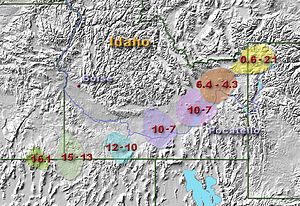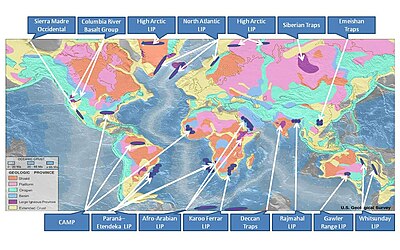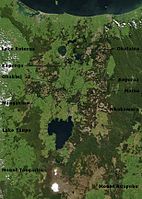Supervolcano
A supervolcano is a volcano that has had an eruption with a volcanic explosivity index (VEI) of 8, the largest recorded value on the index.
This means the volume of deposits for such an eruption is greater than 1,000 cubic kilometers (240 cubic miles).




Supervolcanoes occur when magma in the mantle rises into the crust but is unable to break through it. Pressure builds in a large and growing magma pool until the crust is unable to contain the pressure and ruptures. This can occur at hotspots (for example, Yellowstone Caldera) or at subduction zones (for example, Toba).
Large-volume supervolcanic eruptions are also often associated with large igneous provinces, which can cover huge areas with lava and volcanic ash. These can cause long-lasting climate change (such as the triggering of a small ice age) and threaten species with extinction. The Oruanui eruption of New Zealand's Taupō Volcano (about 26,500 years ago) was the world's most recent VEI-8 eruption.
Terminology
The term "supervolcano" was first used in a volcanic context in 1949. Its origins lie in an early 20th-century scientific debate about the geological history and features of the Three Sisters volcanic region of Oregon in the United States. In 1925, Edwin T. Hodge suggested that a very large volcano, which he named Mount Multnomah, had existed in that region. He believed that several peaks in the Three Sisters area were remnants of Mount Multnomah after it had been largely destroyed by violent volcanic explosions, similarly to Mount Mazama. In his 1948 book The Ancient Volcanoes of Oregon, volcanologist Howel Williams ignored the possible existence of Mount Multnomah, but in 1949 another volcanologist, F. M. Byers Jr., reviewed the book, and in the review, Byers refers to Mount Multnomah as a "supervolcano".
More than fifty years after Byers' review was published, the term supervolcano was popularised by the BBC popular science television program Horizon in 2000, referring to eruptions that produce extremely large amounts of ejecta.
The term megacaldera is sometimes used for caldera supervolcanoes, such as the Blake River Megacaldera Complex in the Abitibi greenstone belt of Ontario and Quebec, Canada.
Though there is no well-defined minimum explosive size for a "supervolcano", there are at least two types of volcanic eruptions that have been identified as supervolcanoes: large igneous provinces and massive eruptions.
Large igneous provinces

Large igneous provinces, such as Iceland, the Siberian Traps, Deccan Traps, and the Ontong Java Plateau, are extensive regions of basalts on a continental scale resulting from flood basalt eruptions. When created, these regions often occupy several thousand square kilometres and have volumes on the order of millions of cubic kilometers. In most cases, the lavas are normally laid down over several million years. They release large amounts of gases.
The Réunion hotspot produced the Deccan Traps about 66 million years ago, coincident with the Cretaceous–Paleogene extinction event. The scientific consensus is that an asteroid impact was the cause of the extinction event, but the volcanic activity may have caused environmental stresses on extant species up to the Cretaceous–Paleogene boundary. Additionally, the largest flood basalt event (the Siberian Traps) occurred around 250 million years ago and was coincident with the largest mass extinction in history, the Permian–Triassic extinction event, although it is unknown whether it was solely responsible for the extinction event.
Such outpourings are not explosive, though lava fountains may occur. Many volcanologists consider Iceland to be a large igneous province that is currently being formed. The last major outpouring occurred in 1783–84 from the Laki fissure, which is approximately 40 km (25 mi) long. An estimated 14 km3 (3.4 cu mi) of basaltic lava was poured out during the eruption (VEI 4).
The Ontong Java Plateau has an area of about 2,000,000 km2 (770,000 sq mi), and the province was at least 50% larger before the Manihiki and Hikurangi Plateaus broke away.
Massive explosive eruptions
Volcanic eruptions are classified using the volcanic explosivity index. It is a logarithmic scale, and an increase of one in VEI number is equivalent to a tenfold increase in volume of erupted material. VEI 7 or VEI 8 eruptions are so powerful that they often form circular calderas rather than cones because the downward withdrawal of magma causes the overlying rock mass to collapse into the empty magma chamber beneath it.
Known super eruptions
Based on incomplete statistics, at least 60 VEI 8 eruptions have been identified.
| Name | Zone | Location | Notes | Years ago (approx.) | Ejecta bulk volume (approx.) | Reference |
|---|---|---|---|---|---|---|
| Youngest Toba eruption | Toba Caldera, North Sumatra | Sumatra, Indonesia | Produced 439–631 million tons of sulfuric acid | 75,000 | 2,000–13,200 km3 | |
| Flat Landing Brook Formation | Tetagouche Group | New Brunswick, Canada | Possibly the largest known supereruption. Existence as a single eruption is controversial, and it could have been a multiple 2,000+ km3 event that spanned less than a million years | 466,000,000 | 2,000–12,000 km3 | |
| Wah Wah Springs Caldera | Indian Peak–Caliente Caldera Complex | Utah, United States | The largest of the Indian Peak-Caliente Caldera Complex eruptions, preserved as the Wah Wah Springs Tuff; includes pyroclastic flows more than 500 meters (1,600 ft) thick | 30,600,000 | 5,500–5,900 km3 | |
| La Garita Caldera | San Juan volcanic field | Colorado, United States | Fish Canyon eruption | 27,800,000 | 5,000 km3 | |
| Grey's Landing Supereruption | Yellowstone hotspot | United States | Deposited the Grey's Landing Ignimbrite | 8,720,000 | 2,800 km3 | |
| La Pacana | Andes Central Volcanic Zone | Chile | Responsible for the Antana Ignimbrite | 4,000,000 | 2,500 km3 | |
| Huckleberry Ridge eruption | Yellowstone hotspot | Idaho, United States | Huckleberry Ridge Tuff; consisted of three distinct eruptions separated by years to decades | 2,100,000 | 2,450–2,500 km3 | |
| Whakamaru Caldera | Taupō Volcanic Zone | North Island, New Zealand | Whakamaru Ignimbrite/Mount Curl Tephra | 340,000 | 2,000 km3 | |
| Heise Volcanic Field | Yellowstone hotspot | Idaho, United States | Kilgore Tuff | 4,500,000 | 1,800 km3 | |
| McMullen Supereruption | Yellowstone hotspot | Southern Idaho, United States | McMullen Ignimbrite | 8,990,000 | 1,700 km3 | |
| Heise Volcanic Field | Yellowstone hotspot | Idaho, United States | Blacktail Tuff | 6,000,000 | 1,500 km3 | |
| Cerro Guacha | Altiplano–Puna volcanic complex | Sur Lípez, Bolivia | Guacha ignimbrite, two smaller eruptions identified | 5,700,000 | 1,300 km3 | |
| Mangakino Caldera | Taupō Volcanic Zone | North Island, New Zealand | Kidnappers eruption | 1,080,000 | 1,200 km3 | |
| Oruanui eruption | Taupō Volcanic Zone | North Island, New Zealand | Taupō Volcano (Lake Taupō) | 26,500 | 1,170 km3 | |
| Galán | Andes Central Volcanic Zone | Catamarca, Argentina | Consisted of three distinct eruptions, separated by 30-40 thousand years | 2,500,000 | 1,050 km3 | |
| Lava Creek eruption | Yellowstone hotspot | Idaho, Montana, and Wyoming, United States | Lava Creek Tuff; consisted of two distinct eruptions separated by years | 640,000 | 1,000 km3 |
Media portrayal
- Nova featured an episode "Mystery of the Megavolcano" in September 2006 examining such eruptions in the last 100,000 years.
- Supervolcano is the title of a British-Canadian television disaster film, first released in 2005. It tells a fictional story of a supereruption at Yellowstone.
- In the 2009 disaster film 2012, a supereruption of Yellowstone is one of the events that contributes to a global cataclysm.
Gallery
- Volcano, lake, and caldera locations in the Taupō Volcanic Zone
See also
- Global catastrophic risk – Potentially harmful worldwide events
- Timeline of volcanism on Earth
- Toba catastrophe theory – Supereruption 74,000 years ago that may have caused a global volcanic winter
- Volcanic winter – Temperature anomaly event caused by a volcanic eruption
Notes
References
Further reading
- Mason, Ben G.; Pyle, David M.; Oppenheimer, Clive (2004). "The size and frequency of the largest explosive eruptions on Earth". Bulletin of Volcanology. 66 (8): 735–748. Bibcode:2004BVol...66..735M. doi:10.1007/s00445-004-0355-9. S2CID 129680497.
- Oppenheimer, C. (2011). Eruptions that shook the world. Cambridge University Press. ISBN 978-0-521-64112-8.
- Timmreck, C.; Graf, H.-F. (2006). "The initial dispersal and radiative forcing of a Northern Hemisphere mid-latitude super volcano: a model study". Atmospheric Chemistry and Physics. 6 (1): 35–49. Bibcode:2006ACP.....6...35T. doi:10.5194/acp-6-35-2006. hdl:11858/00-001M-0000-0011-FD24-C.
External links
- Overview and Transcript of the original BBC program
- Yellowstone Supervolcano and Map of Supervolcanoes Around The World
- USGS Fact Sheet – Steam Explosions, Earthquakes, and Volcanic Eruptions – What's in Yellowstone's Future?
- Scientific American's The Secrets of Supervolcanoes
- Supervolcano eruption mystery solved, BBC Science, 6 January 2014
This article uses material from the Wikipedia English article Supervolcano, which is released under the Creative Commons Attribution-ShareAlike 3.0 license ("CC BY-SA 3.0"); additional terms may apply (view authors). Content is available under CC BY-SA 4.0 unless otherwise noted. Images, videos and audio are available under their respective licenses.
®Wikipedia is a registered trademark of the Wiki Foundation, Inc. Wiki English (DUHOCTRUNGQUOC.VN) is an independent company and has no affiliation with Wiki Foundation.

